At the State of the City, held on Tuesday, May 13, 2025, Mayor Michael Duman described how “cool” Suffolk is and touted many achievements in Suffolk over the past year, as well as many positive aspects of living in Suffolk. He also spoke about “a vision shaped by our community to guide Suffolk’s growth.”
Then a video entitled “Cool Opportunities” was played. Part of it focused on the 2045 Comprehensive Plan and emphasized the importance of agriculture in Suffolk. The video gave the impression that the 2045 Comprehensive Plan was designed around citizen input and would help preserve Suffolk’s agricultural lands. Neither of those two things are true.
The video shows images of beautiful farmland describing how the new 2045 Comprehensive Plan is at the “heart of Suffolk’s future.” The video stated that the plan was “shaped by extensive citizen input” that will preserve “our agricultural heritage”. It goes on further to talk about how agriculture is a huge part of our economy and the importance of rural landscapes as they “define our city’s character.”
In reality the 2045 Comprehensive Plan lays down a framework to destroy significant amounts of farmland, by increasing the growth areas by about 11.5 square miles. This growth will extend into what are predominantly agricultural lands. That is a 15% growth from the previous existing growth area. It makes for the largest comp plan growth area expansion in Suffolk’s history- that is NOT preserving farmland.
The video mentions citizen engagement. Yes, the City did get a tremendous amount of citizen input and kudos to the City for going out into the communities and obtaining all this feedback from its residents. Unfortunately, the City did NOT base the comp plan on that input. Instead, the City of Suffolk ignored the citizens, and focused the comp plan on serving the regional goals of providing more land for warehouses and workforce housing. This video is completely misleading and distorts both the 2045 Comprehensive process and its contents.
During the 2045 Comprehensive Plan process the City received more than 7,500 responses from citizens telling the City what they want for the future of Suffolk. The responses were documented and then summarized, and you can read those here.
WHAT THE PEOPLE ASKED FOR: | 2045 COMP PLAN TO DELIVER |
Small town feel | NO |
Downtown Investment | NO |
Open Space and Parks | NO |
Well planned development | NO |
Fix traffic issues | NO |
Safe, walkable communities | NO |
Invest in public transportation, trails, and rail | MAYBE |
Well planned economic development | NO |
More amenities | MAYBE |
Affordable housing | MAYBE |
Limit warehouses | NO |
Preserve agriculture | NO |
Engage public about their wants and needs | NO |
With the demand from citizens to invest in downtown, City leadership could have focused economic development on downtown, but instead, they carved out new areas for even more warehouses (we already lead Hampton Roads in warehouses.) Instead of limiting warehouse development to existing space and fixing our traffic problems, the 2045 Comprehensive Plan will exacerbate these problems, destroy the open space and farmland that people want to preserve, and ruin that small town feel that Suffolk has.
Before getting public comments, the City met with ‘focus groups’ and staff. It is pretty clear that early on that staff and certain groups of people were able to sway this plan to their desires, and it definitely wasn’t the citizens.
Here are some highlights from those meetings (full summary is here):
WHAT ‘FOCUS GROUPS’ ASKED FOR: | 2045 COMP PLAN TO DELIVER |
Interest in expanding Growth Areas | YES |
Vacant, rural land provides areas for transformative development projects | YES |
Demand is there for continued growth | YES |
Efficient and predictable review process, “speed to build” or will look at other communities. | YES |
Infrastructure costs – water, sewer, and roads can become barriers for industrial development. | YES |
Growth of industrial areas is what drives many of the housing developments. | YES |
There is a shifting need to invest in infrastructure prior to building homes (initial investments for long-term returns) would assist developers. | YES |
City should either allow for more industrial development or limit based on current boundaries; there is a demand so this is a choice for the City to make. | YES |
Renewable energy is looking within the region, planning for this in rural areas is important. | YES |
And in case there is any doubt about the Regional push to shape Suffolk’s 2045 Comprehensive Plan, here is Planning Commissioner Johnny Edwards proclaiming this document as the beginning of shaping Suffolk into a regional leader based on serving the needs of the Port of Virginia.
Planning Commissioner Johnnie Edwards discussing the Planning Commission retreat he attended with a presentation given by the Port of Virginia. (mark 3:55, clipped video from the Planning Commission meeting, August 20, 2024.)
“We are the future of the Region. And we have to start acting like we are the leader of the Region. Because guess what? Those other big cities, they don’t want to be leaders. And someone said in the room, ‘It should be Suffolk’. Well this is where it starts. Because you know what? The port is coming, and it’s going to be great – it’s going to change us forever. And we need to start capitalizing, because the whole world is trying to come to our area. And this plan, in my personal opinion, is the beginning. So yes, it’s time to vote and send this on to City Council.”
After a presentation by the Port of Virginia, the Planning Commissioner explains why this 2045 Comprehensive Plan is so important – it is needed for Suffolk to lead the region in supporting the Port of Virginia. The City chose to focus on the needs of the Port at the expense of the citizens. All of this is in the name of Economic Development.
Here is another video of the Comprehensive Plan’s lead planner, Keith Cannady, giving a presentation as a precursor to the first draft coming out in February 2024. He stated,
“Another major driver, and this is somewhat unique for this particular plan update, is really an historic investment in the Port of Virginia and growth in container traffic at that facility and really changing the dynamic for the state and for the region in terms of economic development and opportunities.”
Comprehensive Plan’s lead planner, Keith Cannady, giving a presentation as a precursor to the first draft coming out in February 2024.
We have the lead planner of the comp plan and a Planning Commissioner both stating that this plan is all about the Port of Virginia, and they should know because the former was in charge of the development of the plan and the latter was on the Planning Commission, the lead body in charge of the whole plan.
This 2045 Comp Plan is the opposite of what the citizen’s of Suffolk said they wanted.
Community Engagement sessions and Open Houses were held throughout the city and during these, the collective voice of the citizens was clear: people were frustrated with traffic and didn’t want any more warehouses. Time after time, the residents from all areas of Suffolk expressed concern that their quality of life was being negatively impacted by warehouses and the heavy truck traffic that comes with them.
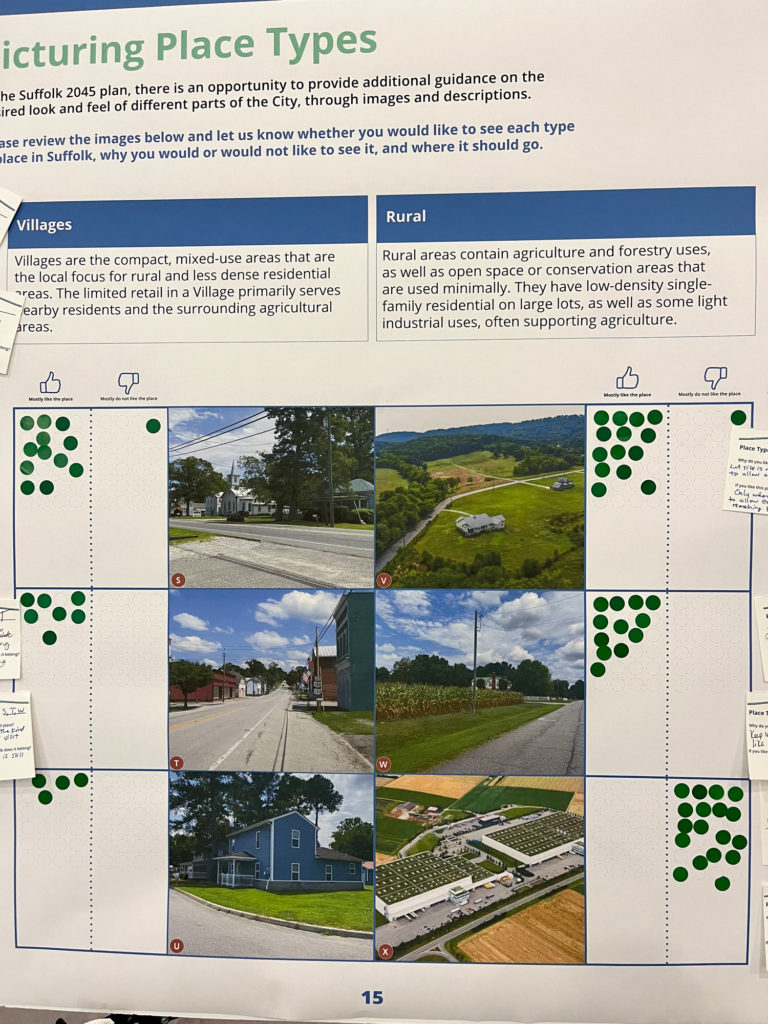
The City wants to push warehouses as economic development but they flatly refused to do a fiscal analysis on the comp plan, something which is typically done and had been part of the original plan. There is absolutely no data to demonstrate that this plan is economically sound for Suffolk’s fiscal future, but plenty to suggest we could be running into financial troubles at the rate we are developing.
Just recently, the Smithfield Times reported on a fiscal impact analysis done for the Isle of Wight. The county was examining “at what point would increased tax revenue fail to offset the added cost to the county’s schools and other public services?”
They found that if they grow 2%+ then their expenses started to out pace their revenues. Suffolk has seen its population grow by 8.7% since 2021.
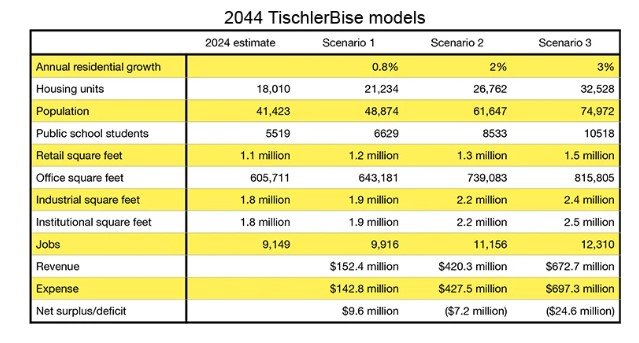
In September 2022, at a comp plan steering committee meeting, there was quite a lengthy presentation about the role of a fiscal impact analysis in the comprehensive planning process. One slide from the presentation shows a comparison of growth beyond the service area compared to growth within the service area, where infrastructure was already in place. It costs more money to extend into areas that lack infrastructure, like roads, water, sewers, storm water drainage, etc. versus building within areas that already contain many of these services. Suffolk’s “managed growth approach” for decades has been to extend growth areas into predominantly agricultural areas, which tend to lack the essential infrastructure needed for large residential neighborhoods and non-residential uses. This method of growth can be more expensive. This was known to those working on the comp plan, and still they refused to do a fiscal impact analysis.
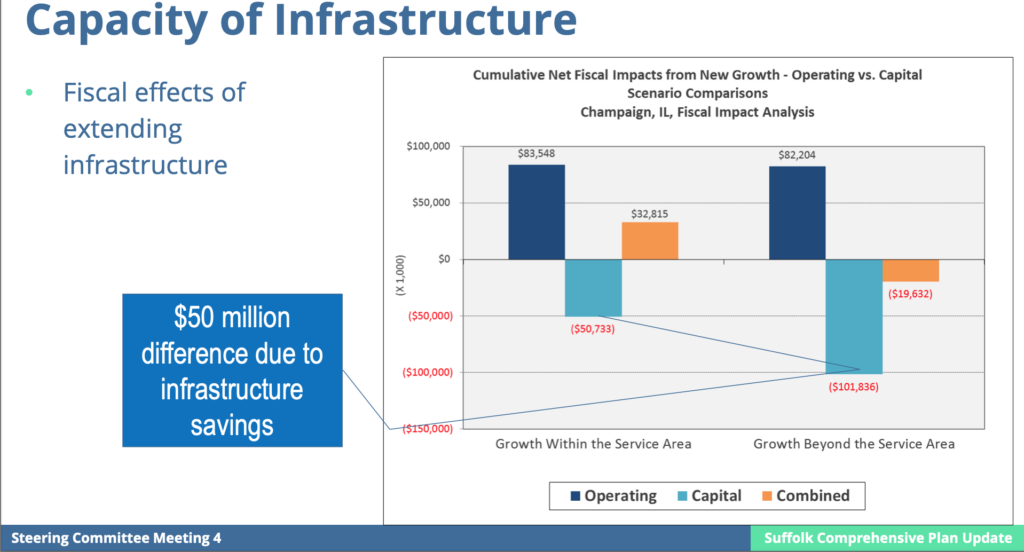
This slide, Capacity of Infrastructure, contains a real life example from Champaign, IL and the two model types it was comparing. Champaign was comparing “Growth Within the Service Area” and “Growth Beyond the Service Area” and the fiscal impact analysis showed that “Growth Beyond the Service Area” created a $50 million difference in additional capital infrastructure costs.
Other data was presented to City Leadership during the comp plan process about how warehousing and distribution may not be a fiscal net positive. Considering how much area was being dedicated to warehouse development for economic development, the citizens felt strongly there should be a fiscal analysis to determine this. The City refused. You can read more about this here, here, and here.
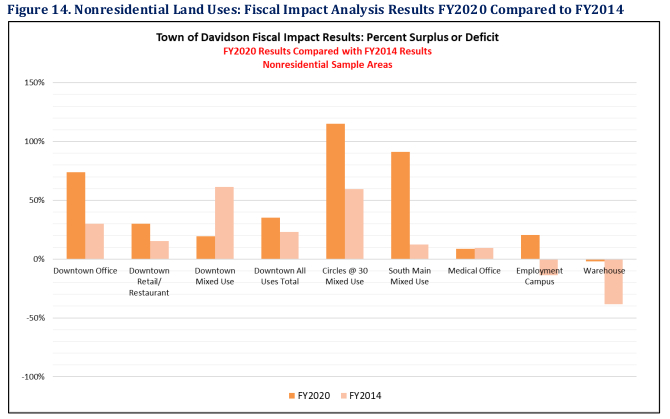
This image is from the Cost of Land Use Fiscal Impact Analysis for the Town of Davidson, North Carolina (p. 17). The Town of Davidson is comparing the fiscal impact (surplus vs deficit) of various non-residential land use types from 2014 compared to 2020. Notice that the warehouses are net negative, from 2014 to 2020.
This is an excerpt from Fiscal Impact Analysis: Reader Beware: Some Caveats by Paul Tischler of TischlerBise. This excerpt states that a fiscal analysis should be completed prior to developing the plan.
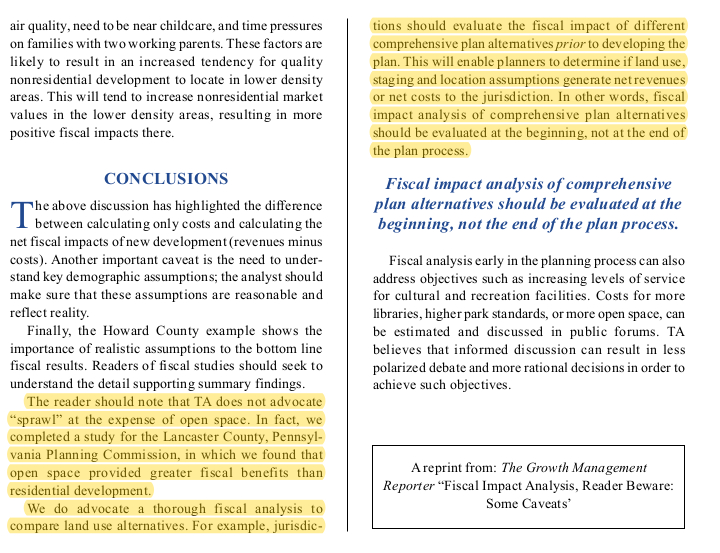
It also states that it “does not advocate ‘sprawl’ at the expense of open space. In fact we completed a study for Lancaster County, Pennsylvania Planning Commission, in which we found that open space provided greater fiscal benefits than residential developments.”
Workforce housing is the counterpart to the warehouse development in this plan, with the majority of new uses being designated for these two components.
The 2045 Comprehensive Plan dragged on beyond its original schedule in part BECAUSE of public opposition. The plan went through several council leadership changes due to controversies. Additionally, it was an election year and the mayor and three other council members were up for re-election. The vote on the plan was continually pushed back through 2024. On November 20, 2024, AFTER the election, the City held the last public hearing on the 2045 Comprehensive Plan. However, they held off voting on it that night when the Council Chamber was filled with frustrated citizens. Council pushed the comp plan vote to the December 18 meeting, the last meeting that would have Council Member Roger Fawcett, Chair of the 2045 Comprehensive Plan, because he failed to win re-election and recently elected Ebony Wright would be taking his seat in January of 2025.
The City failed to give public notice before voting to approve the comprehensive plan, despite the requirement by Virginia State law.
The City claimed that no public notice was required because there was no public hearing scheduled for the agenda item “to amend the comprehensive plan for 2035 and adopt Suffolk 2045, The City of Suffolk Comprehensive Plan as the City of Suffolk’s
comprehensive plan.”
However, the law reads as follows:
“The local planning commission shall not recommend nor the governing body adopt any plan, ordinance or amendment thereof until notice of intention to do so has been published twice in some newspaper published or having general circulation in the locality, with the first notice appearing no more than 28 days before and the second notice appearing no less than seven days before the date of the meeting referenced in the notice;”
The Mayor, City Council, the Clerk’s Office, the City Manager, the Deputy City Manager, and the Lead Planner on the comp plan were all notified about the failure to provide the public with proper notice prior to the vote. Yet City Council proceeded as planned.
Not only did City Council fail to provide notice before approving the plan, they literally added changes to the land use map at the eleventh hour. They were presented with the changes at the Work Session which was scheduled at 4pm, two hours before the Council meeting when it was approved. They added about 3.5 square miles of land on Rt. 58 that would allow warehouses to be built to the north and high density housing to be built to the south, on land that is predominantly agricultural. This area was not part of the comp plan when the final public hearing was held, nor was there any public notice given that this 3.5 square mile was to be added.
The 2045 Comprehensive Plan is about providing land for warehouses and workforce housing for the Port of Virginia- not about what the citizens of Suffolk want for their city and future. The citizens’ feedback was ignored in favor of what staff and the ‘focus groups’ wanted. Then City Council went about approving the comp plan with NO transparency and a total disregard to the rights of the citizens: by refusing to conduct a fiscal analysis, by delaying, adding last minute changes of a drastic nature, failing to provide another public hearing, failing to provide the Virginia state mandated public notice, and then voting for the plan and against the will of the people.
For all of these reasons, this video from the State of City was an insult to the citizens of Suffolk. These images of farming, rural landscapes, and the agricultural aspects of Suffolk were the qualities the citizens wanted to preserve during the comp plan process, but we were told that in the name of economic development, we need to sacrifice this land. This video shows the beauty of Suffolk that the 2045 Comprehensive Plan will be destroying, not protecting. City Leadership knows Suffolk is proud of its agricultural heritage, and pays lip service to it on occasion, but when it comes right down to it, the 2045 Comprehensive Plan and the State of the City of Suffolk is all about regional goals. (You can read more here, here, and here.) The State of the City is not hosted by the City itself. It is sponsored and supported by the Hampton Roads Chamber, which does this as a series each year to highlight economic development throughout the Hampton Roads Region.
“You know, one of the things that we as a region take great pride in is the fact that we’ve got literally the best port in the entire United States, their CEO is with us today. I want to recognize him, Mr. Stephen Edwards is here.”
– Bryan K. Stephens, President and CEO of Hampton Roads Chamber, during the Suffolk State of the City
(mark 18:04-18:16)
It’s no wonder the presenter wanted to acknowledge the Port of Virginia and its representative- it’s listed as one of their strategic partners. This video may have played well in a room full of who’s who in the political and business nexus of Hampton Roads, but to the thousands of citizens of Suffolk who provided feedback to help shape Suffolk’s future, this video is a slap in the face. These images are what we wanted but instead we will be getting more warehouses, more traffic, more overcrowded schools, and more taxes to pay for the infrastructure. Those are the true images that will be the results of this new 2045 Comprehensive Plan, but then, most of these regional figures won’t have to deal with the aftermath.
